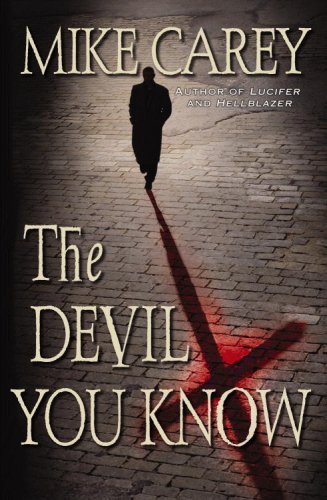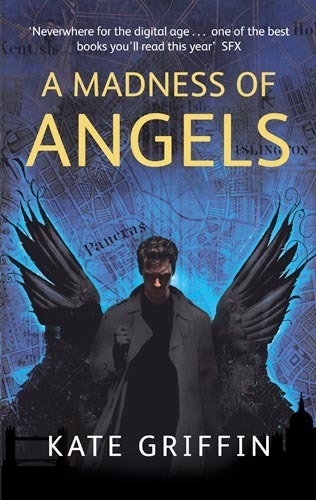Stephen Morris's Blog, page 50
January 5, 2014
12th Night, Part I
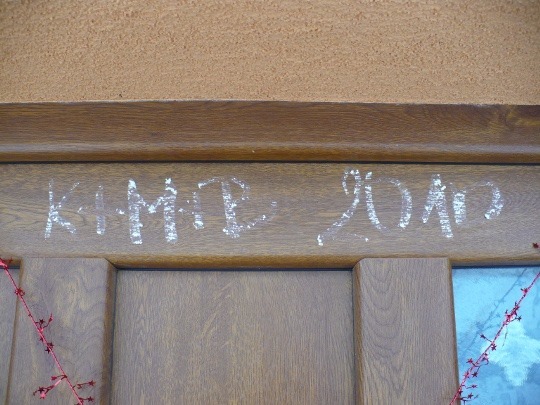
Czech doors inscribed with Epiphany blessing
Western Christians observe a twelve-day festival, starting on December 25, and ending on January 5, known as Christmastide or the Twelve Days of Christmas. Christmas ends with the celebration of Epiphany (January 6), the end of the Twelve Days.
On the Feast of the Epiphany, the priest, wearing white vestments, will bless the Epiphany water, frankincense, gold, and chalk. Chalk is used to write the initials of the three magi over the doors of churches and homes. The letters stand for the initials of the Magi (traditionally named Caspar, Melchior, and Balthasar), and also the phrase Christus mansionem benedicat, which translates as “may Christ bless the house”.
According to ancient custom, the priest announced the date of Easter on the feast of Epiphany. This tradition dated from a time when calendars were not readily available, and the church needed to publicize the date of Easter, since many celebrations of the liturgical year depend on it. The proclamation may be sung or proclaimed at the ambo by a deacon, cantor, or reader either after the reading of the Gospel or after the post-communion prayer. (In New York City, the only church I know to do this according to the proper chant is the Church of St. Mary the Virgin in Times Square.)
The Roman Missal thus provides a formula with appropriate chant (in the tone of the Exsultet) for proclaiming on Epiphany, wherever it is customary to do so, the dates in the calendar for the celebration of Ash Wednesday, Easter, and other holy days that will mark the following liturgical year.
December 30, 2013
“Good Yule!”
 Yule or Yuletide (“Yule time”) is a religious festival observed by the historical Germanic peoples, later being absorbed into and equated with the Christian festival of Christmas. The earliest references to Yule are by way of indigenous Germanic month names (Ærra Jéola (Before Yule) or Jiuli and Æftera Jéola (After Yule). Scholars have connected the celebration to the Wild Hunt, the god Odin and the pagan Anglo-Saxon Modranicht.
Yule or Yuletide (“Yule time”) is a religious festival observed by the historical Germanic peoples, later being absorbed into and equated with the Christian festival of Christmas. The earliest references to Yule are by way of indigenous Germanic month names (Ærra Jéola (Before Yule) or Jiuli and Æftera Jéola (After Yule). Scholars have connected the celebration to the Wild Hunt, the god Odin and the pagan Anglo-Saxon Modranicht.
Terms with an etymological equivalent to Yule are used in the Nordic countries for Christmas with its religious rites, but also for the holidays of this season. Yule is also used to a lesser extent in English-speaking countries to refer to Christmas. Customs such as the Yule log, Yule goat, Yule boar, Yule singing, and others stem from Yule.
Yule is the modern English representative of the Old English words ġéol or ġéohol and ġéola or ġéoli, with the former indicating the 12-day festival of “Yule” (later: “Christmastime”) and the latter indicating the month of “Yule”, whereby ǽrra ġéola referred to the period before the Yule festival (December) and æftera ġéola referred to the period after Yule (January). Both words are thought to be derived from Common Germanic, and are cognate to Gothic (fruma) jiuleis and Old Norse (Icelandic and Faroese) jól (Danish and Swedish jul and Norwegian jul or jol) as well as ýlir, Estonian jõulud and Finnish joulu. The etymological pedigree of the word, however, remains uncertain, though numerous speculative attempts have been made to find Indo-European cognates outside the Germanic group, too.
The noun Yuletide is first attested from around 1475.
The word is attested in an explicitly pre-Christian context primarily in Old Norse. Among many others, the long-bearded god Odin bears the names jólfaðr (Old Norse ‘Yule father’) and jólnir (Old Norse ‘the Yule one’). In plural (Old Norse jólnar; ‘the Yule ones’) may refer to the Norse gods in general. In Old Norse poetry, the word is often employed as a synonym for ‘feast’, such as in the kenning hugins jól (Old Norse ‘Huginn’s Yule’ > ‘a raven’s feast’).
Yule was an indigenous midwinter festival celebrated by the Germanic peoples, absorbed into celebrations surrounding Christmas over time with Christianization. The earliest references to it are in the form of month names, where the Yule-tide period lasts somewhere around two months in length, falling along the end of the modern calendar year between what is now mid-November and early January.
December 26, 2013
Good King Wenceslas!
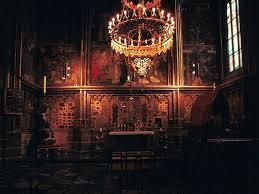
The shrine-chapel of St. Duke Vaclav (Wenceslaus) in St. Vitus’ Cathedral (Prague).
Good King Wenceslas is a popular Christmas carol that tells a story of Good King Wenceslas braving harsh winter weather to give alms to a poor peasant on the Feast of Stephen (the second day of Christmas, December 26). During the journey, his page is about to give up the struggle against the cold weather, but is enabled to continue by following the king’s footprints, step for step, through the deep snow. The legend is based on the life of the historical Saint Wenceslaus I, Duke of Bohemia or Svatý Václav in Czech (907–935).
In 1853, English hymnwriter John Mason Neale wrote the “Wenceslas” lyrics, in collaboration with his music editor Thomas Helmore, and the carol first appeared in Carols for Christmas-Tide, 1853. Neale’s lyrics were set to a tune based on a 13th-century spring carol “Tempus adest floridum” (“The time is near for flowering”) first published in the 1582 Finnish song collection Piae Cantiones.
Wenceslas was considered a martyr and a saint immediately after his death in the 10th century, when a cult of Wenceslas grew up in Bohemia and in England. Within a few decades of Wenceslas’s death, four biographies of him were in circulation. These hagiographies had a powerful influence on the High Middle Ages conceptualization of the rex justus, or “righteous king”—that is, a monarch whose power stems mainly from his great piety, as well as from his princely vigor.
Although Wenceslas was, during his lifetime, only a duke, Holy Roman Emperor Otto I posthumously “conferred on [Wenceslas] the regal dignity and title” and that is why, in the legend and song, he is referred to as a “king”. The usual English spelling of Duke Wenceslas’s name, Wenceslaus, is occasionally encountered in later textual variants of the carol, although it was not used by Neale in his version. (Wenceslas is not to be confused with King Wenceslaus I of Bohemia [Wenceslaus I Premyslid], who lived more than three centuries later).
December 22, 2013
“O Christmas Tree, How Lovely Are Thy Branches!”

Christmas Tree at the Metropolitan Museum of Art in NYC with decorations from Naples (mid-late 1700s).
Christmas trees are among the most popular holiday customs of the modern world. Of all sizes and of many shapes, trees are set up in homes and shopping malls and store aisles to be decked with lights, tinsel, and ornaments. Children look forward to the arrival of the tree and share in its decoration. The decorated tree is the surest sign that the “holiday season” has arrived.But some disparage Christmas trees and call them little more than pagan intrusions into the Christian celebration. They cite the sacred trees of the Germanic tribes and assert that the decorated trees in modern houses are an ongoing homage to Thor, Odin, and the other gods of Valhalla. Although certain trees were considered sacred and might be decorated to celebrate certain days, no Germanic pagan would ever dream of cutting down the sacred trees or bringing them indoors. Cutting down the trees was the work of the Christian missionaries, especially St. Boniface of Mainz.
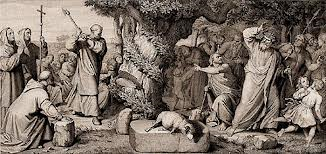
Depiction of St. Boniface cutting down Thor’s Oak.
Cutting down the holy trees was an act of desecration against the gods of Valhalla and an assertion that they were powerless to stop such a violation of their memory. When St. Boniface began to cut down Thor’s Oak, it is said that “suddenly a great wind, as if by miracle, blew the ancient oak over. When the god did not strike him down, the people were amazed and converted to Christianity. He built a chapel dedicated to Saint Peter from its wood…”
Although the pagan Germanic celebration of the midwinter feast of Yule describes great feasting, there are no mentions of decorated trees. The “Yule logs” were ordinary trees that were cut down and brought in to be burnt, not the sacred trees. To cut down and bring the tree indoors, decorate it, and then burn it is an act specific to the newly-converted Germanic peoples to celebrate the end of the old gods and the birthday of the new.
December 19, 2013
Turquiose, birthstone of December
In ancient Persia it was once believed that the wearing of turquoise talismans would protect the wearer from death. It was also believed – not only among Persians but also among a number of other cultures – that a change in the color of the turquoise was a sign of danger or illness. Turquoise was carried by physicians of the fifteenth century. They claimed that the stone would counter the harmful effects of poison. They prepared a potion containing finely powdered turquoise, which, as well as proving to be a powerful antidote to scorpion stings, was also considered effective in banishing the pains arising from possession by demons.
Turks often attached Turquoise to the bridles of their horses believing that it rendered the horse more sure-footed. As the horse was often regarded as a symbol of the sun in its rapid course through the heavens, the sky-blue color of Turquoise may have caused it to be associated in some way with the horse.
The name turquoise is apparently related to the fact that is was brought to Europe from the Eastern Mediterranean by Levantine traders, more commonly known as Turks. Its been used as a valuable ornament for ages and was used by the Egyptians thousands of years ago. The color is, of course, turquoise, but its range of color varies from green and greenish blue to sky blue shades.
For centuries, the most valuable turquoise came from Iran (Persia) but today some specimens mined in the southwestern United States compete with it. The name “Persian Turquoise” is now generally used to refer to any turquoise stone that does not have the black or brown veining commonly found in turquoise mined in the United States.
December 16, 2013
Felix Castor
This wonderful series of 5 novels follows the escapades of Felix Castor, an exorcist in contemporary London, who uses the tunes of his flute to bind the ghosts which possess the living and force them back into the shadow-world where they belong. In the London where Felix lives, the dead have made themselves known and are openly moving among the living in a variety of ways and Felix’s skills are in frequent demand. Each of the five books is a wonderful stand-alone novel in which Felix struggles to save both his clients and himself from the ghosts and demons which hide in plain sight all around us, though the overarching arc of the five books describes his attempt to free his friend from the demon Asmodeus (the demon which Felix himself inadvertently linked to his friend’s soul).
This first book in the series, The Devil You Know, introduces us to Felix’s world and characters–both living and departed– that populate it. The author includes fascinating descriptions of how magic and exorcism work and how the dead are able to cross over into the realm of the living.
The author makes one choice at the end of the first book which I would not have made, but it is the only way that makes that character able to have not only a recurring role in the series but a vital one in one of the later books of the quintet. I am happy to suggest that you add the Felix Castor books to your reading list!
December 12, 2013
Sagittarius
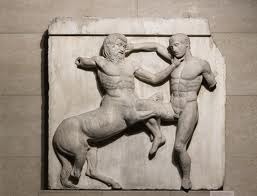
This carving from the Parthenon depicts hand-to-hand (Hand-to-hoof?) combat between a centaur and a human.
Sagittarius (the astrological sign of those born November 23–December 22) is one of the 48 constellations listed by the 2nd-century astronomer Ptolemy and remains one of the 88 modern constellations. Its name is Latin for “the archer,” and its symbol is  , a stylized arrow.
, a stylized arrow.
The Babylonians identified Sagittarius as the god Nerigal or Nergal, a strange centaur-like creature firing an arrow from a bow. It is generally depicted with wings, with two heads, one panther head and one human head, as well as a scorpion’s stinger raised above its more conventional horse’s tail. The Sumerian name Pabilsag is composed of two elements – Pabil, meaning ‘elder paternal kinsman’ and Sag, meaning ‘chief, head’. The name may thus be translated as the ‘Forefather’ or ‘Chief Ancestor’. The figure is reminiscent of modern depictions of Sagittarius.
In Greek mythology, Sagittarius is identified as a centaur: half human, half horse. In some legends, the Centaur Chiron was the son of Philyra and Saturn, who was said to have changed himself into a horse to escape his jealous wife, Rhea. Chiron was eventually immortalised in the constellation of Centaurus or in some version, Sagittarius.
The arrow of this constellation points towards the star Antares, the “heart of the scorpion.”
Sagittarius is undoubtedly one of the most positive of the star signs. If you were born under this sign, you are extremely confident in whatever you do. Being one of the luckiest signs, fortune seems to favor you, whether you plan things or not. That’s also the reason you don’t mind taking the odd risk or two. You feel as if you can’t possibly lose. This almost cocky attitude is something that attracts people to you.
You’re also very enthusiastic, and this is contagious — people can’t help but feel the same way in your presence.
Because people like you so much, they want to help you achieve your goals. But sometimes your life objectives are colossal — those arrows seem to shoot much further than the eye can see. Your philosophy is to bite off more than you can chew and then chew as fast as you can.
People around you will sometimes feel that you’re overly ambitious, and that your aims are pie in the sky. This is not likely to change you: you’d always rather aim high and take on the adventure of life than get to the end of the road regretting that you didn’t have a good go at making your dreams come true.
December 9, 2013
Midnight Mayor
This is one of my all-time favorite series by a fantastic author! A lyric prose-poem that is a love song to London and magic! The word-paintings of London in this first book of the Midnight Mayor series are breathtaking and the way in which Matthew Swift uses the contemporary magic of cities in general –London, in particular–makes us realize how magic is all around us if only we open our eyes to see it, even in the subways! (In an interview, Kate Griffin said that scene in the subway was probably her favorite in the book! It was a good thing I had just passed that scene when I found her interview!) I urge you to add Madness of Angels and the other Midnight Mayor books to your bedside table!
As the story opens, Matthew Swift finds himself breathing once again, lying in bed in his London home. Except that it’s no longer his bed, or his home. And the last time this sorcerer was seen alive, an unknown assailant had gouged a hole so deep in his chest that his death was irrefutable…despite his body never being found. Matthew realizes that he is not entirely himself when he glimpses his reflection in a mirror and his eyes (which had been brown) are now the “pale, brilliant albino blue of the cloudless winter sky, and I was no longer the only creature that watched from behind their lens.”
Matthew (and the creatures that are also looking through those albino blue eyes of his) goes on to search for his killer and stop the killer and his dark minions, especially the shadow-entity Matthew comes to refer to as Hunger as the being is the killer’s hunger for power and dominion externalized. As Matthew finds each of his killer’s assistants and strikes them down in a variety of impressive ways, we meet the Bag Lady and the Beggar King and the other archetypes that populate the shadows of London. A Madness of Angels and the Midnight Mayor series are exquisite!
December 3, 2013
Dec. 5, 1484: Pope Authorizes Inquisition Against Witches
[image error]
Francisco Goya’s 1789 painting, “Witches’ Sabbath”
During what is known as the Little Ice Age, the grip of freezing weather, failing of crops, rising crime, and mass starvation resulted in an increasing fear of witches. On the request of German inquisitor Heinrich Kramer, Innocent VIII issued the papal bull known as Summis desiderantes(5 December 1484), which supported Kramer’s investigations against magicians and witches:
“It has recently come to our ears, not without great pain to us, that in some parts of upper Germany, [...] Mainz, Koin, Trier, Salzburg, and Bremen, many persons of both sexes, heedless of their own salvation and forsaking the catholic faith, give themselves over to devils male and female, and by their incantations, charms, and conjurings, and by other abominable superstitions and sortileges, offences, crimes, and misdeeds, ruin and cause to perish the offspring of women, the foal of animals, the products of the earth, the grapes of vines, and the fruits of trees, as well as men and women, cattle and flocks and herds and animals of every kind, vineyards also and orchards, meadows, pastures, harvests, grains and other fruits of the earth; that they afflict and torture with dire pains and anguish, both internal and external, these men, women, cattle, flocks, herds, and animals, and hinder men from begetting [...]“
Pope Innocent’s statement also includes a warning against sexual encounters with demons. It was thought that a succubus collects semen from the men she seduces. The incubi or male demons then use the semen to impregnate human females, thus explaining how demons could apparently sire children despite the traditional belief that they were incapable of reproduction. Children so begotten – cambions – were supposed to be those that were born deformed, or more susceptible to supernatural influences. The book does not address why a human female impregnated with the semen of a human male would not produce a regular human offspring. But in some Viking lore the child is born deformed because the conception was unnatural.
November 25, 2013
Topaz
Topaz was one of the original gems on the breastplate of the Jewish high priest, inscribed to with the name of one of the twelve tribes of Israel. While many of the birthstones have been changed over the millennia, topaz is one gem that is almost universally accepted as November’s birthstone; it is the gem of the zodiac sign Sagittarius. It is also called Sunday’s gemstone-and it associated with the sun.
Indeed, St. John in Revelation writes that topaz was “touched by the splendor of the sun.” He lists topaz as the ninth foundation stone–each of the stones represents a Christian virtue. To St. John, topaz is the clearest of all gemstones and signifies contemplation which expands the heart and aligns men with the nine orders of angels.
The name, “topaz,” comes from the island, Topazio, which is in the Red Sea. It was commonly used as an amulet as protection from the “evil eye.” The theme of a cure of eyes runs though some of the early Christian writing from the tenth century. St. Hildegard of Bingen claimed the gem was so brilliant that it illuminated prayers in a dark chapel, and claimed the gem was a cure of dim vision. She recommended placing a piece of topaz in white wine for three days and nights, then rubbing the eye with the stone before sleep with the wet stone and using the wine as an eye wash.
Other “healing” applications vary over the centuries. Powdered topaz placed in wine cured asthma, burns, insomnia and hemorrhage. It was said to cure sadness and make you more intelligent and was particularly powerful if used in moonlight. Pope Clement VI and Pope Gregory II claimed that topaz could even cure the sores from the plague.


